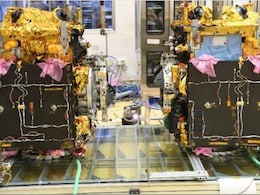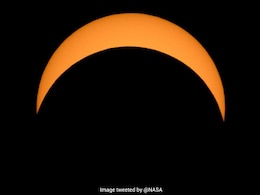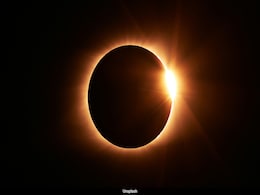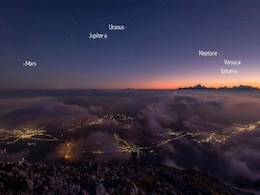Celestis
- All
- News
-

Solar Eclipse 2025: Best Viewing Locations, Safety Tips And How To Watch
- Friday March 28, 2025
- Science | Edited by Bhavya Sukheja
Skywatchers and astronomy enthusiasts are in for a spectacular celestial event as a partial solar eclipse is set to take place on March 29, Saturday.
-
 www.ndtv.com
www.ndtv.com
-

India's Satellites In Space Dance, 500km Above Earth At 28,800 Kmph
- Friday March 28, 2025
- India News | Written by Pallava Bagla
A rare celestial dance is being orchestrated by the Indian Space Research Organisation - two satellites - flying at 28,800 kilometers per hour or speeds ten times that of a bullet - are circling each other in precision formation flight.
-
 www.ndtv.com
www.ndtv.com
-

Solar Eclipse On March 29: Will It Be Visible In India? All You Need To Know
- Wednesday March 26, 2025
- Science | Edited by Bhavya Sukheja
A partial solar eclipse is set to take place on Saturday, March 29. This celestial event will be the first solar eclipse of 2025.
-
 www.ndtv.com
www.ndtv.com
-

Saturn's Rings To 'Disappear' Today In A Rare Celestial Event, Here's Why It Happens
- Sunday March 23, 2025
- Science | Edited by Ritu Singh
The rare phenomenon will start on Sunday, March 23, at 12:04 p.m. EDT (9:34 pm in India) and extend for a few days.
-
 www.ndtv.com
www.ndtv.com
-

Life on Mars? Studies Suggest Bacteria-Like Organisms Could Exist
- Thursday March 13, 2025
- Written by Gadgets 360 Staff
New findings indicate that Mars' past conditions may have supported microbial life. Research draws parallels with extremophiles—microorganisms that thrive in extreme environments on Earth. Studies on bacteria like Helicobacter pylori suggest that if life exists on Mars, it might resemble resilient microbes found in human stomachs. Scientists cont...
-
 www.gadgets360.com
www.gadgets360.com
-

SpaceX Falcon 9 Successfully Deploys NASA’s SPHEREx Telescope and PUNCH Probes
- Thursday March 13, 2025
- Written by Gadgets 360 Staff
NASA’s SPHEREx and PUNCH missions have successfully launched aboard a SpaceX Falcon 9 rocket from Vandenberg Space Force Base in California. SPHEREx will map the entire celestial sky in 102 infrared colours, while PUNCH will study the transition of the sun’s corona into the solar wind. The two-year missions aim to deepen our understanding of th...
-
 www.gadgets360.com
www.gadgets360.com
-

Hubble Captures Stunning Infrared Image of Sh2-284, a Massive Stellar Nursery
- Wednesday March 12, 2025
- Written by Gadgets 360 Staff
Hubble’s latest image of the massive Sh2-284 nebula reveals young stars concealed within thick clouds of gas and dust. Using infrared imaging, astronomers have captured details previously obscured in optical wavelengths. The nebula’s low-metallicity composition provides a glimpse into the conditions of the early universe, shedding light on how ...
-
 www.gadgets360.com
www.gadgets360.com
-

First Solar Eclipse Of 2025 This Month, Will It Be Visible From India?
- Monday March 10, 2025
- World News | Edited by NDTV News Desk
The first solar eclipse of the year is set to occur on March 29. The celestial event takes place when the Moon is closer to Earth and passes directly between the Earth and the Sun, blocking sunlight and casting a shadow on Earth's surface.
-
 www.ndtv.com
www.ndtv.com
-

James Webb Space Telescope Observes Mysterious Rogue Planet-Like Object
- Thursday March 6, 2025
- Written by Gadgets 360 Staff
The James Webb Space Telescope has captured new insights into SIMP 0136, a planetary-mass object floating freely around 20 light-years away. This celestial body, possibly a rogue planet or a brown dwarf, has puzzled astronomers for years. JWST’s infrared observations have revealed intricate cloud layers, temperature shifts, and potential chemical...
-
 www.gadgets360.com
www.gadgets360.com
-

T Coronae Borealis Nova Event: When and Where to See the 'Blaze Star'
- Wednesday March 5, 2025
- Written by Gadgets 360 Staff
T Coronae Borealis, also known as the 'Blaze Star,' is predicted to undergo a rare nova event, briefly making it visible to the naked eye. This recurrent nova, last seen erupting in 1946, is expected to brighten anytime between now and late 2024. Positioned in the constellation Corona Borealis, the star will be best visible a few hours after sunset...
-
 www.gadgets360.com
www.gadgets360.com
-

Planetary Parade 2025: Rare Photo Captures Earth And 7 Planets For The First Time Ever
- Thursday February 27, 2025
- Science | Edited by Ritu Singh
Experts have claimed it could be the first time all planets including Earth have been captured in a single image.
-
 www.ndtv.com
www.ndtv.com
-

Rare Seven-Planet Alignment 2025: How to Watch in India, Best Viewing Tips
- Monday February 24, 2025
- Written by Gadgets 360 Staff
A rare celestial event featuring seven planets—Mercury, Venus, Mars, Jupiter, Saturn, Uranus, and Neptune—aligning along the ecliptic will be visible in 2025. The alignment starts on February 28, with the best viewing in India on March 3. Venus and Jupiter will be easily visible, while Uranus and Neptune will require a telescope. Experts sugges...
-
 www.gadgets360.com
www.gadgets360.com
-

7 Planets To Align Next Week, Here's How To Watch This Rare Celestial Event From India
- Friday February 21, 2025
- Science | Edited by Bhavya Sukheja
A rare celestial event is set to occur on February 28, when all planets in our solar system will be visible in the night sky briefly.
-
 www.ndtv.com
www.ndtv.com
-

Hubble’s New Image of Tarantula Nebula Showcases Cosmic Dust and Star Formation
- Tuesday February 18, 2025
- Written by Gadgets 360 Staff
NASA/ESA’s Hubble Space Telescope has captured a breathtaking image of the Tarantula Nebula, located 160,000 light-years away in the Large Magellanic Cloud. The image reveals intricate cosmic dust patterns and active star formation, offering valuable insights into the role of interstellar material in stellar evolution. Researchers are using the d...
-
 www.gadgets360.com
www.gadgets360.com
-

Astronomers Spot a High-Speed Star That May Carry a Planet With It
- Friday February 14, 2025
- Written by Gadgets 360 Staff
Astronomers have identified a celestial object moving through the Milky Way at over 1.2 million mph. Believed to be a small star with a possible massive exoplanet, the discovery could mark the fastest-known planetary system. If its speed exceeds 1.3 million mph, it may eventually escape the galaxy. Scientists are still verifying whether it is the s...
-
 www.gadgets360.com
www.gadgets360.com
-

Solar Eclipse 2025: Best Viewing Locations, Safety Tips And How To Watch
- Friday March 28, 2025
- Science | Edited by Bhavya Sukheja
Skywatchers and astronomy enthusiasts are in for a spectacular celestial event as a partial solar eclipse is set to take place on March 29, Saturday.
-
 www.ndtv.com
www.ndtv.com
-

India's Satellites In Space Dance, 500km Above Earth At 28,800 Kmph
- Friday March 28, 2025
- India News | Written by Pallava Bagla
A rare celestial dance is being orchestrated by the Indian Space Research Organisation - two satellites - flying at 28,800 kilometers per hour or speeds ten times that of a bullet - are circling each other in precision formation flight.
-
 www.ndtv.com
www.ndtv.com
-

Solar Eclipse On March 29: Will It Be Visible In India? All You Need To Know
- Wednesday March 26, 2025
- Science | Edited by Bhavya Sukheja
A partial solar eclipse is set to take place on Saturday, March 29. This celestial event will be the first solar eclipse of 2025.
-
 www.ndtv.com
www.ndtv.com
-

Saturn's Rings To 'Disappear' Today In A Rare Celestial Event, Here's Why It Happens
- Sunday March 23, 2025
- Science | Edited by Ritu Singh
The rare phenomenon will start on Sunday, March 23, at 12:04 p.m. EDT (9:34 pm in India) and extend for a few days.
-
 www.ndtv.com
www.ndtv.com
-

Life on Mars? Studies Suggest Bacteria-Like Organisms Could Exist
- Thursday March 13, 2025
- Written by Gadgets 360 Staff
New findings indicate that Mars' past conditions may have supported microbial life. Research draws parallels with extremophiles—microorganisms that thrive in extreme environments on Earth. Studies on bacteria like Helicobacter pylori suggest that if life exists on Mars, it might resemble resilient microbes found in human stomachs. Scientists cont...
-
 www.gadgets360.com
www.gadgets360.com
-

SpaceX Falcon 9 Successfully Deploys NASA’s SPHEREx Telescope and PUNCH Probes
- Thursday March 13, 2025
- Written by Gadgets 360 Staff
NASA’s SPHEREx and PUNCH missions have successfully launched aboard a SpaceX Falcon 9 rocket from Vandenberg Space Force Base in California. SPHEREx will map the entire celestial sky in 102 infrared colours, while PUNCH will study the transition of the sun’s corona into the solar wind. The two-year missions aim to deepen our understanding of th...
-
 www.gadgets360.com
www.gadgets360.com
-

Hubble Captures Stunning Infrared Image of Sh2-284, a Massive Stellar Nursery
- Wednesday March 12, 2025
- Written by Gadgets 360 Staff
Hubble’s latest image of the massive Sh2-284 nebula reveals young stars concealed within thick clouds of gas and dust. Using infrared imaging, astronomers have captured details previously obscured in optical wavelengths. The nebula’s low-metallicity composition provides a glimpse into the conditions of the early universe, shedding light on how ...
-
 www.gadgets360.com
www.gadgets360.com
-

First Solar Eclipse Of 2025 This Month, Will It Be Visible From India?
- Monday March 10, 2025
- World News | Edited by NDTV News Desk
The first solar eclipse of the year is set to occur on March 29. The celestial event takes place when the Moon is closer to Earth and passes directly between the Earth and the Sun, blocking sunlight and casting a shadow on Earth's surface.
-
 www.ndtv.com
www.ndtv.com
-

James Webb Space Telescope Observes Mysterious Rogue Planet-Like Object
- Thursday March 6, 2025
- Written by Gadgets 360 Staff
The James Webb Space Telescope has captured new insights into SIMP 0136, a planetary-mass object floating freely around 20 light-years away. This celestial body, possibly a rogue planet or a brown dwarf, has puzzled astronomers for years. JWST’s infrared observations have revealed intricate cloud layers, temperature shifts, and potential chemical...
-
 www.gadgets360.com
www.gadgets360.com
-

T Coronae Borealis Nova Event: When and Where to See the 'Blaze Star'
- Wednesday March 5, 2025
- Written by Gadgets 360 Staff
T Coronae Borealis, also known as the 'Blaze Star,' is predicted to undergo a rare nova event, briefly making it visible to the naked eye. This recurrent nova, last seen erupting in 1946, is expected to brighten anytime between now and late 2024. Positioned in the constellation Corona Borealis, the star will be best visible a few hours after sunset...
-
 www.gadgets360.com
www.gadgets360.com
-

Planetary Parade 2025: Rare Photo Captures Earth And 7 Planets For The First Time Ever
- Thursday February 27, 2025
- Science | Edited by Ritu Singh
Experts have claimed it could be the first time all planets including Earth have been captured in a single image.
-
 www.ndtv.com
www.ndtv.com
-

Rare Seven-Planet Alignment 2025: How to Watch in India, Best Viewing Tips
- Monday February 24, 2025
- Written by Gadgets 360 Staff
A rare celestial event featuring seven planets—Mercury, Venus, Mars, Jupiter, Saturn, Uranus, and Neptune—aligning along the ecliptic will be visible in 2025. The alignment starts on February 28, with the best viewing in India on March 3. Venus and Jupiter will be easily visible, while Uranus and Neptune will require a telescope. Experts sugges...
-
 www.gadgets360.com
www.gadgets360.com
-

7 Planets To Align Next Week, Here's How To Watch This Rare Celestial Event From India
- Friday February 21, 2025
- Science | Edited by Bhavya Sukheja
A rare celestial event is set to occur on February 28, when all planets in our solar system will be visible in the night sky briefly.
-
 www.ndtv.com
www.ndtv.com
-

Hubble’s New Image of Tarantula Nebula Showcases Cosmic Dust and Star Formation
- Tuesday February 18, 2025
- Written by Gadgets 360 Staff
NASA/ESA’s Hubble Space Telescope has captured a breathtaking image of the Tarantula Nebula, located 160,000 light-years away in the Large Magellanic Cloud. The image reveals intricate cosmic dust patterns and active star formation, offering valuable insights into the role of interstellar material in stellar evolution. Researchers are using the d...
-
 www.gadgets360.com
www.gadgets360.com
-

Astronomers Spot a High-Speed Star That May Carry a Planet With It
- Friday February 14, 2025
- Written by Gadgets 360 Staff
Astronomers have identified a celestial object moving through the Milky Way at over 1.2 million mph. Believed to be a small star with a possible massive exoplanet, the discovery could mark the fastest-known planetary system. If its speed exceeds 1.3 million mph, it may eventually escape the galaxy. Scientists are still verifying whether it is the s...
-
 www.gadgets360.com
www.gadgets360.com
















